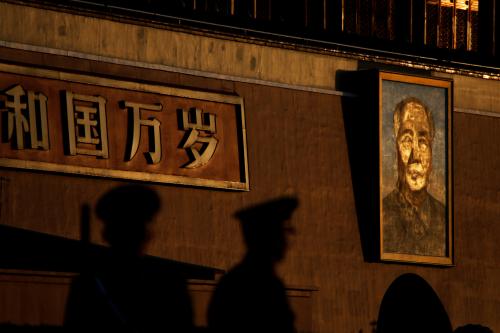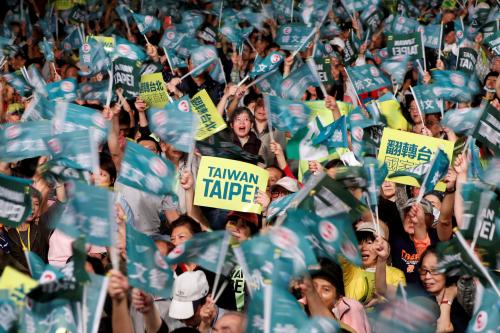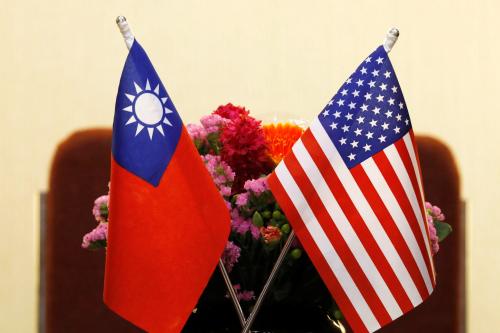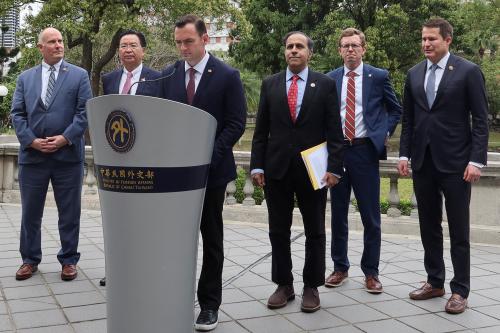Richard C. Bush delivered this speech at the Taipei Forum in Taiwan on June 5, 2019.
It is a great pleasure to speak to you today, at this event sponsored by Taipei Forum.1 I’m deeply grateful to my Columbia tongxue Su Chi for inviting me. It’s wonderful to see so many long-time friends. Thank you for coming today. I just arrived in Taipei yesterday evening. I am pretty confident that I will stay awake through this morning’s program. I hope I remain alert during the question-and-answer period and even have an insight or two.
I have come to Taiwan this time for several different reasons, not just to speak to you today. One reason is that Brookings and the College of International Affairs2 are hosting a conference on Monday, June 17, as part of a Brookings project called “Sustaining the Long East Asian Peace.” We began this project recently and are very pleased that Taipei is the site of our first event in Asia. Again, the conference is on June 17 at the Hotel Palais de Chine.
Now I don’t have to tell this audience that Taiwan faces an array of challenges. I would guess that you agree with my view that Taiwan will meet those challenges best if there is a broad consensus on how to do so. It needs organizations like Taipei Forum in order to chart a future course that has public support.
Having good relations with the United States will, I hope, be part of Taiwan’s future. Our bilateral relationship has evolved a great deal since the Kuomintang retreated to Taiwan in 1949. There have been ups and downs. Some periods were better than others. Both Washington and Taipei always need to understand the perspective of the other, understand its hopes and fears. And of course the People’s Republic of China is always a factor.
I will talk today about the Trump administration’s policies towards Taiwan. I use the word the plural word “policies’ deliberately, for reasons I will make clear. I am not going to spend too much time on a textual analysis of what the Trump administration says or, in addition, what Congress says about Taiwan policy. The various verbal formulae that the U.S. government uses in various ways at various times are definitely important. I myself take credit for creating one of those formulae. But I will focus more on what the Administration does.
Let me present my main points here at the outset, so you will know where I am going.
- First, this administration’s stated policy towards China is the most hostile of any since the Eisenhower administration. It emphasizes competition and leaves little role for cooperation.
- Second, the Trump administration’s policies toward Taiwan diverge in their objectives. Some are positive, and others are negative.
- Third, the administration’s process for formulating and implementing policy is broken, which contributes to the policy divergence.
- Fourth, it has become clear that the economic conflict between Beijing and Washington is much more than a trade war. It is an economic war fought on three fronts: trade, investment, and technology. The escalation of this war has had negative consequences for Taiwan’s interests. To use a military analogy, Taiwan is the victim of “friendly fire,” where soldiers are accidentally killed or wounded by their own comrades.
Free and Open Indo-Pacific
I begin by addressing the Trump administration’s strategy of a free and open Indo-Pacific. Since the term was first enunciated, administration officials have struggled to elaborate what it meant in detail. When giving a positive spin, they defined the various aspects of the words “free” and “open.” But the National Security Strategy issued in late 2017 and the unclassified summary of the National Defense Strategy, issued in early 2018, presented a more negative focus interpretation on China, but they were still rather general because they covered the whole world. The Pentagon’s “Indo-Pacific Strategy Report,” which was issued four days ago, goes into much greater detail about this region. It is worth reading.
The Report confirms the negative approach to China. Acting Secretary Patrick Shanahan’s transmittal letter makes this clear statement:
“Inter-state strategic competition, defined by geopolitical rivalry between free and repressive world order visions, is the primary concern for U.S. national security. In particular, the People’s Republic of China, under the leadership of the Chinese Communist Party, seeks to reorder the region to its advantage by leveraging military modernization, influence operations, and predatory economics to coerce other nations.”
The title of the section on the PRC refers to it as a “revisionist power,” which is a loaded term. There is a clear statement of Beijing’s objectives: “As China continues its economic and military ascendance, it seeks Indo-Pacific regional hegemony in the near-term and, ultimately global preeminence in the long-term.”
The Report focuses on the military and economic tools that the PRC is using to project power outward. That, of course, increases the vulnerability of Japan, South Korea, Taiwan, and the countries of Southeast Asia. The Report advocates both a military and economic response. The military side includes expanding our presence in the Western Pacific and then using our forces in a more competitive way. I will return to the economic component in a minute.
There are a number of ways in which the Trump administration’s Free and Open Indo-Pacific Strategy was similar to President Obama’s “rebalance to Asia.” But the biggest difference between them concerns China. President Obama sought to enhance areas of competition between the United States and China – regarding climate change, Iran, and North Korea. It sought to manage the competition in areas like East Asia’s maritime domain. For Obama, cooperation was for its own sake but it also provided balance to the relationship and kept it from tipping into mutual conflict.
In many parts of the Trump administration, however, there is more of a “you-live-I-die” approach to China. In addition, the U.S. Congress is highly critical of China’s policies in a variety of areas. Interestingly, opinion polling suggests that the American public is not as negative about China’s intentions and behavior as the administration is.
With this background regarding China and East Asia, let me now turn to the Trump administration’s Taiwan policies, plural. I will start by looking at the positive part of the list and then turn to the negative side.
Positive Aspects
The principal positive side of U.S. Taiwan policy is defense. U.S. officials seek to broaden and deepen the security relationship with Taiwan. This follows logically from their judgment that China is a revisionist power that wishes to diminish the U.S. influence in East Asia. There is the geographical fact that Taiwan is one link in the first-island chain.
The Pentagon’s recent strategy report speaks clearly to Taiwan’s importance:
- It says that a “strong, prosperous, and democratic Taiwan” is part of the rules-based order that America has a vital interest in upholding.
- It reports that the U.S. is pursuing a strong partnership with Taiwan, particularly in light of Beijing’s pressure campaign against Taiwan.
- It reaffirms the commitment to faithfully implement the Taiwan Relations Act.
But the report goes beyond these general statements to define our bilateral partnership. Specifically, “The objective of our defense engagement with Taiwan is to ensure that Taiwan remains secure, confident, free from coercion, and able to peacefully and productively engage the mainland on its own terms.”
In addition to arms sales pursuant to the TRA, it says that, “DoD is continually engaged in evaluating Taiwan’s defense needs to assist Taiwan in identifying capabilities that are mobile, survivable, and effective in resisting the use of force or other forms of coercion.”
As with previous administrations, the Pentagon under Trump has mostly conducted enhanced security cooperation with Taiwan quietly. It assumes that Beijing knows these activities are happening, but avoids creating public, diplomatic disputes. But China is not the only reason a lot of this is occurring quietly.
Also on the positive side of the ledger is Congress and the State Department. I think you have observed some of the ways in which the State Department has gradually been broadening the conduct of the U.S.-Taiwan relations. We have seen a number of U.S. officials visiting Taiwan in the last two years.
In Congress, Taiwan has a lot of support. This is mainly a function of the anti-China mood on Capitol Hill, and Beijing for its part believes that Congress is actively contributing to the pro-Taiwan side of the administration’s policy. What is worth noting, however, is that the pieces of legislation that Congress has passed so far to encourage enhanced diplomatic and military interaction with Taiwan have no binding effect. They express sentiments and make suggestions but do not require the president to do anything he may prefer not to. Congress could craft these pieces of legislation in the form of orders, but they would arguably encroach on the president’s constitutional powers as commander in chief and head diplomat.
As I hinted before, one question about the U.S. policy of strategic competition with China is whether it is actually in the interests of America’s friends and allies in East Asia. Do they see China as an enemy? They may see it as a security danger, but they all have engaged China economically, often to their great benefit. Can they afford to align with the United States on both security and economics? Taiwan is not the only place asking these questions, but it is something of a special case. So this is a good point to turn to the Trump administration’s economic policy towards Taiwan.
Economic Policy
So that’s U.S. security policy towards Taiwan, and it is positive. The other side of Trump administration policy is economic, and this is more negative. Early on, there was the increase in steel and aluminum tariffs, based on an abuse of U.S. trade law. More fundamentally, the Office of the U.S. Trade Representative (USTR) and the Department of Commerce continue to hold to the view that Taiwan reneged on certain commitments regarding market access for American beef and pork and that those must be resolved before discussions will begin on topics of interest to Taiwan, such as a bilateral investment agreement or a bilateral free trade agreement. These forward-looking initiatives would strengthen Taiwan economically, which would fortify its overall position vis-à-vis China. But USTR and Commerce prefer to play hardball.
In addition, at least some people in the Trump administration do not understand that in using tariffs to put pressure on China, they are simultaneously hurting the economies through which the global supply chains run, particularly the supply chains for IT products. President Trump has now put many of those IT products on the table, not realizing that much of their value-added occurs here, not on the Mainland.
This divergence between the U.S. security and economic agencies creates a fundamental contradiction in the administration’s Taiwan policy. If Taiwan is the strategic asset, as the Pentagon appears to believe, then it makes no sense to hold it back economically. Even though Taiwan did renege on its commitments on beef and pork, those could be resolved in the course of negotiations on larger issues, in recognition of Taiwan’s supposed strategic significance.
Policy Chaos
Why, you may ask, does this divergence occur? Partly it is the result of an ongoing bureaucratic fight between trade agencies on the one hand and diplomatic and security agencies on the other. Yet the divergence is even worse under the Trump administration because the regular process of policy-making has broken down.
Briefly, that process since the late 1940s had had these characteristics:
- It was inclusive. It allowed and required the different agencies who had a stake in any given issue to talk to each other and try to find policy consensus.
- Second, the process was bottom-up. Issues requiring decisions were discussed at higher and higher levels, until recommendations reached the desk of the president.
- Third, because the process was bottom-up, it benefitted from the expertise of officials at working levels. As a result, senior officials had a better sense of the consequences and trade-offs involved in any decision.
- Finally, it was institutionalized, enshrined in a set of rules that each new administration enunciated as it came into office.
As I suggested, this process has broken down. Decisions are not coordinated. Contending agencies act independently. Mistakes get made. An effective policy process could reconcile the conflict between our Taiwan security policy and our Taiwan trade policy. Without a good process, we treat Taiwan in a schizophrenic way.
President Trump
I need to mention one other negative aspect of the Trump administration – both policy and process – that is very important for friends in Taiwan to understand. That is President Trump himself. He has affected his own administration’s Taiwan policy in a unique and vacillating way.
As president-elect, he seemed to tilt in a favorable direction by taking a phone call from President Tsai Ing-wen on December 2, 2016. Nine days later, however, he talked as if he wanted to use Taiwan merely as leverage against China on trade and North Korea. Thereafter, it seems that Trump has been willing to defer to China’s President Xi Jinping on matters concerning Taiwan. In a September 6, 2018 column in the Washington Post, Josh Rogin reported this statement from a “senior administration official”: “This administration, from a personnel perspective, has the most hawkish Taiwan team ever…But if Xi calls [Donald Trump] and complains, the president’s instinct is to defer to that because there is always some pending issue in which we want something from the Chinese.”
Also, there is a question about President Trump’s personal commitment to Taiwan’s security. Since the termination of the U.S.-ROC mutual defense treaty in 1980, Washington has no legal requirement to come to Taiwan’s defense. But that commitment is certainly implicit in the U.S. policy statements, as long as Taiwan itself does not provoke a conflict.
Yet, in Fear: Trump in the White House, Bob Woodward’s account of the first year of the administration, Woodward recounts a January 19, 2018 meeting at the White House where Trump and his national security team discussed—not for the first time—the rationale for the United States defending allies and partners. In this particular argument, Trump first asked, “What do we get by maintaining a massive military presence in the Korean Peninsula?” He then asked, out of the blue, “Even more than that, what do we get from protecting Taiwan, say?” (It is worth noting the implication of this question. President Trump believes that past administrations have had some sort of commitment to come to Taiwan’s defense.)
By the way, the president’s attitude is neither new nor Taiwan-specific. He has always been skeptical of the value of our post-war alliances. He has been skeptical of the forward deployment of the U.S. armed forces. He has been skeptical of American young men and women fighting to help friendly countries defend themselves.
“Friendly Fire”
I would now like to address the issue of “friendly fire,” the negative impact of U.S.-China economic conflicts on Taiwan’s own economy.
I must note at the outset that American companies have real and serious complaints about the business environment in China. You know the complaints as well as I do. If Hillary Clinton had been elected president in 2016 her administration would have pressured China on its industrial policies.
President Trump took a different approach. On the one hand, he relied on increasing tariffs or the threat of increased tariffs to pressure Beijing to bring greater balance to U.S.-PRC bilateral trade, and to provide leverage to USTR in its effort was to get Beijing change the interface between American companies and the Chinese economy, to the benefit of those companies. These were the trade and investment fronts of the economic war.
On the other hand, President Trump empowered some of his more hardline officials to pursue a very different and, I think, pernicious set of objectives that form the technology front of the economic war. One objective was to create a set of incentives for American companies with operations in China to get out and move their supply chains somewhere else, either to other countries or back to the United States. The assumption here is that the American economy had become too dependent on the Chinese economy and this dependence would harm not only our economic competitiveness but also our national security.
The other part of the American hard-liners’ agenda concerned what they saw as an existential competition with China, not over goods and services but over advanced technology. They believed that because many technologies can be used for both commercial and military purposes, this competition would determine not only whether China or America would dominate the global economy in the future but also whose armed forces would be preeminent. For the hard-liners, this really was a case of “you live, I die” or vice versa.
The administration’s recent imposition of controls on Huawei have gotten a lot of news coverage. For example, is the American ban on Huawei good or bad for Taiwan. But this is not just about Huawei. It covers a much broader scope of the Chinese economy.
The Trump administration’s answer to this technology competition is to create a system of trade and investment controls. PRC entities wishing to invest in the United States and PRC students and scholars involved in sensitive fields in U.S. universities are coming under more scrutiny. Most important, transfers of American technology that could benefit China will come under licensing process, similar to that in the Cold War.
The strategy here is to exploit the dependence of rising firms like Huawei, ZTE, and Fujian Jinhua on external inputs, particularly semiconductors. Banning these companies from buying foreign semiconductors and other components amounts to a death sentence.
We all understand that this is not like the era of the Cold War, and that globalization has integrated the international economy to an unprecedented degree. As a result, implementing export controls on China will be difficult. But the Trump administration is trying. Fourteen critical technology areas were identified in the Export Control Reform Act passed in July last year. As I speak, the Commerce Department is compiling a detailed list of companies and technologies that will be subject to license. Reportedly, seven Taiwan companies are on the list.
The export control requirement will apply to U.S. companies, overseas affiliates, foreign companies with U.S. operations or connections of a very wide scope. For example, the new controls define as an American product any item that has at least 25 percent American content.
What does this mean for Taiwan and its many companies with ties to both American and Chinese companies. A Taiwan lawyer friend of mine who has studied these developments has developed this speculative scenario:
“Any Taiwanese company that has a direct or indirect business operation, joint venture or partnership in the United States, if it also engages in any research concerning development of artificial intelligence and machine learning related chipsets with a Chinese company, must apply to the United States Government for a license in order for this technology to be deployed in China, or otherwise released to a China national located in the U.S. That is true even if no substantive products are to be exported to a foreign country or a foreign national located in the U.S.”
The presumption is that the license will be denied.
I am a pure layman when it comes to the IT business, but since many Taiwan IT companies have both U.S. and PRC partners, I suspect that this export control regime will cause them a tsunami of trouble. It will be a bonanza for the lawyers who prepare the license applications, but for those who produce the hardware and software on the control list, it’s a nightmare. This, my friends, is what de-coupling is all about. This is the 21st definition of friendly fire.
Implications
What is the bottom line here?
- First, U.S.-Taiwan relations are in good shape because they have been addressed on their own merits. I am glad that the Pentagon wishes to help strengthen Taiwan’s deterrent and prefer that it does so quietly. I wish our economic agencies would agree to discuss initiatives to significantly strengthen Taiwan’s economy. I am cautiously pleased that President Trump is no longer considering using Taiwan as a bargaining chip. So far so good. But I worry that he might go back to the idea.
- Second, Taiwan should focus not only on shifts in U.S. policy but also on how our broken system of policy formulation affect the substance of policy.
- Third, the Trump administration and Congress have clearly decided in words and deeds to approach China in an intensely more competitive manner. Both the economic and security agencies favor this approach, especially the focus on technology. In some ways, this works to Taiwan’s advantage. In other ways, it works to Taiwan’s disadvantage.
- Fourth, it is too early to know the scope, duration, and implications of the U.S. competition. The emergence of the U.S. export control regime has made so-called trade negotiations much more complicated. Even without that issue, reaching agreement on the issues under negotiation for the last year was getting harder, what with Trump’s increase of some tariffs last month and his threat of more, and with China’s apparent backing away from commitments it had made. But naming Huawei as an entity of concern and the problem of Ms. Meng’s extradition case, Beijing will probably fold Huawei into the current negotiations and try to get Trump to back down. More broadly, as I have suggested, Huawei is only the tip of a very big iceberg.
There are some implications of this American policy approach for Taiwan. First of all, even if U.S.-China relations becomes a zero-sum struggle, Taiwan won’t necessarily and automatically be the beneficiary. This is particularly true when it comes to economics, as you know as well as I do, U.S. economic objectives concerning the PRC – on tariffs, on the location of supply chains, on advanced technologies – all can have serious consequences for Taiwan. All these issues increase uncertainty and the cost of doing business.
Second, although some parts of the U.S. government are quite supportive of Taiwan, others are not. For those in Taiwan who believe that U.S. support is absolute, they need to think again. There is no blank check here. Taiwan needs to consider carefully how to balance its interests vis-à-vis the United States and the PRC.
Third, there are ways that Taiwan can help itself – economically, and politically. I personally worry that Beijing will rely increasingly on PRC pressure and intimidation – coercion without violence.
Finally, based on my warning about friendly fire, I believe that Taiwan officials need to convey clear messages to their U.S. counterparts about the unintended, negative consequences for Taiwan of U.S. economic policy towards China. We all understand the constraints here, but Taiwan is blessed with many friends in Washington.
Thank you for your attention. I wish that I could provide you with a more positive report than the one I have given today. But I feel it is my duty as a friend to be honest and frank. Thank you again. I look forward to your questions.
-
Footnotes
- Taipei Forum Foundation event at the Chang Yung-fa Foundation, Taipei.
- College of International Affairs, National Chengchi University, Taipei.






Commentary
The Trump administration’s policies toward Taiwan
June 5, 2019